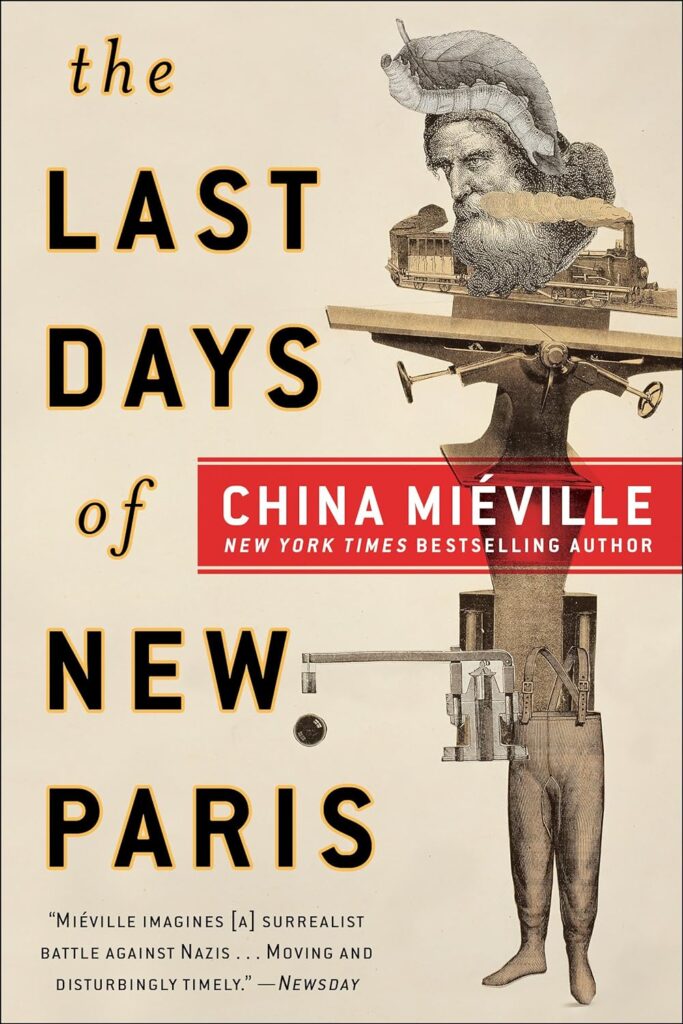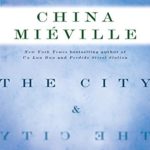I’m a fan of China Miéville‘s fiction, but when I first started The Last Days of New Paris, I was a little baffled. There was a woman riding a velocipede/centaur heading straight into a line of mannequins in a can-can row behind which Nazis were shooting at her, all this in 1950. The prose was taut, exciting, all action in short bursts, but what were those things called manifs, and what was Main à Plume? And what was the significance of the playing card, the dying velocipede rider passes on to the observer, Thibault? And why is he draped in a white and gold threaded nightdress that repels bullets? It took me a while to warm up to this and figure it all out, but once I did, The Last Days of New Paris became one of my favorite Miéville stories.
New Paris is a strange reality blown into existence in 1941 by something called the S-Blast. The wild energies released into the city by this explosion saw the creations of surrealist art come to life, as manifestations or manifs, and join the fight against the Nazi occupiers.
“Thibaut was fifteen when the S-Blast came. A call like a far-off siren, by the river, and a wave of shadow and silence racing out and leaving young Thibaut wheezing for breath and blinking with eyes gone momentarily unseeing, and the city poised and primed behind it, something emergent, something irrupting into and from its unconscious. A dream invaded from below. What had been the world’s prettiest city was now populated by its own unpretty imaginings, and by the ugliness of the pit.”
The Last Days of New Paris, Kindle edition, Page 13
In the 1950 of this story, Thibault is now in his mid-twenties and has joined Main à Plume, a group of surrealist resistance fighters. He meets a woman of unknown affiliation named Sam who carries a camera she uses to take pictures of surrealist manifs but also to shoot at Nazis. He is fascinated by her photographs, which are supposed to go into a book, and he decides to follow her. Thibault also links up with one of the manifs, the Exquisite Corpse, from a creation by André Breton and other artists, pictured on the cover of the novella.
Like all surrealist painting and sculpture, the corpse consists of completely dissimilar objects or body parts yoked together. The surrealists aimed to join the worlds of dream and reality into a super reality. In this alternate 1950, Thibault has long become accustomed to manifs, impossible to manage but generally helpful to the resistance fighters. When he encounters the Exquisite Corpse he attaches a sash to it, as it refuses to follow anyone else, and draws it with him for much of the story. He first met this manifestation shortly after the S-Blast when his family was killed by panicked German soldiers. In the midst of that disaster, he first saw this strange apparition.
“He was looking into a metal grille. The visor of a plumed knight’s helmet. It was vastly too big. It was centimeters from his own face. The helmeted presence stared at him. He blinked and its metal trembled. … The thing swayed up and back from the flesh and debris of the killing ground. It reared, seven, eight meters tall, an impossible composite of tower and human and a great shield, all out of scale and made one looming body, handless arms held almost dainty by its sides, its left thronging with horseflies. It declared itself mournfully, an echoing call of faceplate hinges. When that noise ebbed the huge thing stalked away at last on three limbs: one huge spurred man’s leg; a pair of women’s high-heeled feet.”
The Last Days of New Paris, Kindle edition, Page 14-15
To explain the origins of New Paris, Miéville takes the story back to 1941 Marseilles. There he fictionalizes a historical incident, the gathering of surrealist and other artists and intellectuals, including many Jews, at a villa outside the city as they waited for American visas that would let them escape from occupied France. Varian Fry really did head the Emergency Rescue Committee that worked with a member of the American embassy staff to get the visas for such people as André Breton, Marc Chagall, Hannah Arendt, Walter Benjamin and thousands of others.
Into their midst, Miéville places another real person, Jack Parsons, who was an important figure in the development of US rocketry and jet propulsion. But in this story Parsons is searching for words that he can use as sources of energy. Supposedly, what he is looking for is in Prague, but since he can’t get there in 1941 Europe, he turns his attention to the surrealists. At first he has contempt for them, but as he watches them playing with a set of cards the artists have created (another real incident) he begins to see new possibilities. So he sets up his box full of electronics and a special battery designed to draw energy from verbal and artistic sources and soon realizes he has hit on something amazing, the potential energy in the surrealist creations.
Eventually, these story strands come together, but that’s all I’ll reveal for now. The whole novel is full of exciting action, made all the more meaningful once you decode the strange nature of New Paris. It helped me to go to the Afterward and a following supplement that explain how Miéville encountered an aged Thibault who told him this wild story and also identifies most of the real surrealist images that come to life in it. While there are a few illustrations, it would have been better to be able to see the originals on which the manifestations are based. However, those originals do not have the human feelings and mannerisms that Miéville endows them with, as is so well brought to life in the description above of the Exquisite Corpse.
As with every Miéville novel I’ve read, it helps to re-read The Last Days of New Paris. He hits you with so many strange and bizarre creations that it takes a couple of passes to grasp how they work and how brilliantly interesting they are. I suppose not so many people will go to that trouble, but it’s well worth the time.





Leave a Reply